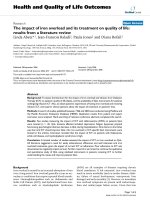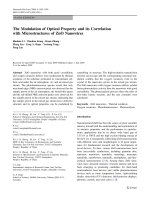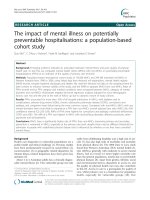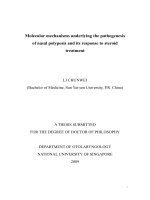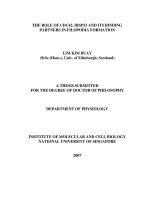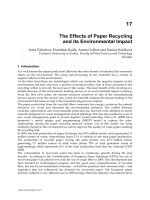(The state of mental illness and its therapy) autumn libal postpartum disorders (2014)
Bạn đang xem bản rút gọn của tài liệu. Xem và tải ngay bản đầy đủ của tài liệu tại đây (4.1 MB, 130 trang )
NHMC13_HBK_MentalIllness_NHMC13_HBK_MentalIlness_HBK 4/15/13 3:19 PM Page 12
Everyone told Sandra she would be happy. People described in rapt detail the overwhelming
feeling of love and purpose that would envelop her at her daughter’s birth. Nothing prepared
Sandra for the heavy fog of dread and loss that descended upon her in the delivery room on the
day she gave birth. When the nurse handed her the crying, bruised, purple-pink bundle, Sandra
had to fight the urge to hand the bundle back and run. She wanted to turn the clock back nine
months before any of this had happened. When she did spend time with her daughter, instead
of singing soothing lullabies, Sandra found herself whispering, “I hate you. I wish you had never
been born.”
Pregnancy, childbirth, and early motherhood is supposed to be a time filled with the joy
and wonder of bringing a new life into the world. Unfortunately, some women find that the
struggles of early motherhood are accompanied by multiple sorrows that clash with this picturesque ideal. As difficult as it may be for a person who has not experienced it to understand,
Sandra’s feelings are quite common among new mothers struggling with the physical,
emotional, and social upheaval that follows giving birth. In this transitional period, some women
become more vulnerable to depression and may experience psychiatric disorders such as
postpartum depression and postpartum psychosis.
Postpartum Disorders will tell you more about these disorders, the experiences of the
women who have faced them, and the treatments that can help.
BE SURE
TO READ
OTHER
BOOKS
IN THIS
SERIES
EAN
ISBN 978-1-4222-2832-6
9 781422 228326
90000
Postpartum Disorders
The State of
Mental Illness
and Its Therapy
Adjustment Disorders
Anxiety Disorders
Cognitive Disorders
Childhood & Adolescent Disorders
Dissociative Disorders
Eating Disorders
Impulse-Control Disorders
Mental Disorders Due to a Medical Condition
Mood Disorders
Obsessive-Compulsive Disorder
Personality Disorders
Postpartum Disorders
Premenstrual Disorders
Psychosomatic Disorders
Schizophrenia
Sexual Disorders
Sleep Disorders
Substance-Related Disorders
The FDA & Psychiatric Drugs: How a Drug Is Approved
The State of
Mental Illness
and Its Therapy
Postpartum Disorders
Autumn Libal
Mason Crest
Mason Crest
450 Parkway Drive, Suite D
Broomall, PA 19008
www.masoncrest.com
Copyright © 2014 by Mason Crest, an imprint of National Highlights, Inc. All rights reserved. No
part of this publication may be reproduced or transmitted in any form or by any means, electronic
or mechanical, including photocopying, recording, taping or any information storage and retrieval
system, without permission from the publisher.
Printed in the Hashemite Kingdom of Jordan.
First printing
987654321
Series ISBN: 978-1-4222-2819-7
ISBN: 978-1-4222-2832-6
ebook ISBN: 978-1-4222-8993-8
The Library of Congress has cataloged the
hardcopy format(s) as follows:
Library of Congress Cataloging-in-Publication Data
Libal, Autumn.
[Drug therapy and postpartum disorders]
Postpartum disorders / Autumn Libal.
pages cm. – (The state of mental illness and its therapy)
Audience: Age 12.
Audience: Grade 7 to 8.
Revision of: Drug therapy and postpartum disorders. 2004.
Includes bibliographical references and index.
ISBN 978-1-4222-2832-6 (hardcover) – ISBN 978-1-4222-2819-7 (series) – ISBN 978-1-4222-8993-8
(ebook)
1. Postpartum psychiatric disorders–Juvenile literature. 2. Postpartum psychiatric disorders–
Treatment–Juvenile literature. 3. Postpartum psychiatric disorders–Chemotherapy–Juvenile literature. I. Title.
RG850.L53 2014
618.7’6061–dc23
2013008259
Produced by Vestal Creative Services.
www.vestalcreative.com
This book is meant to educate and should not be used as an alternative to appropriate medical care. Its creators have made every effort to ensure that the information presented is accurate—but it is not intended to
substitute for the help and services of trained professionals.
Picture Credits:
Artville: pp. 25, 63, 86, 91, 100, 102, 103, 110, 112, 114, 117, 118, 122. Corbis: pp. 14, 19, 22, 46 (bottom). Digivision: pp. 10, 61, 104. Eclectic Collections: pp. 36, 70. National Library of Medicine: pp. 41,
45, 46 (top), 62, 99. PhotoDisc: pp. 12, 20, 23, 26, 29, 30, 31, 32, 33, 39, 50, 53, 54, 57, 58, 68, 74,
75, 79, 80, 82, 84, 88, 92, 96, 108, 113, 120. U.S. Library of Congress: p. 42. The individuals in these images are models, and the images are for illustrative purposes only. To the best knowledge of the publisher,
all other images are in the public domain. If any image has been inadvertantly uncredited or miscredited, please notify Vestal Creative Services, Vestal, New York 13850, so that rectification can be made for
future printings.
Contents
Introduction
7
Foreword
9
1. What Are Postpartum Disorders?
11
2. History of Therapy and Drug Treatment
37
3. How Some Psychiatric Drugs Work
51
4. Treatment Description
69
5. Two Women’s Stories
83
6. Risks and Side Effects
97
7. Alternative and Supplementary Treatments
109
Further Reading
125
For More Information
126
Index
127
About the Author & Consultants
128
Introduction
T
by Mary Ann McDonnell
eenagers have reason to be interested in psychiatric disorders
and their treatment. Friends, family members, and even teens
themselves may experience one of these disorders. Using scenarios adolescents will understand, this series explains various psychiatric disorders and the drugs that treat them.
Diagnosis and treatment of psychiatric disorders in children between six and eighteen years old are well studied and documented
in the scientific journals. A paper appearing in the Journal of the
American Academy of Child and Adolescent Psychiatry in 2010 estimated that 49.5 percent of all adolescents aged 13 to 18 were
affected by at least one psychiatric disorder. Various other studies
have reported similar findings. Needless to say, many children and
adolescents are suffering from psychiatric disorders and are in need
of treatment.
Many children have more than one psychiatric disorder, which
complicates their diagnoses and treatment plans. Psychiatric disorders often occur together. For instance, a person with a sleep disorder may also be depressed; a teenager with attention-deficit/hyperactivity disorder (ADHD) may also have a substance-use disorder. In
psychiatry, we call this comorbidity. Much research addressing this
issue has led to improved diagnosis and treatment.
The most common child and adolescent psychiatric disorders are
anxiety disorders, depressive disorders, and ADHD. Sleep disorders,
sexual disorders, eating disorders, substance-abuse disorders, and
psychotic disorders are also quite common. This series has volumes
that address each of these disorders.
Major depressive disorders have been the most commonly diagnosed mood disorders for children and adolescents. Researchers
don’t agree as to how common mania and bipolar disorder are in
7
children. Some experts believe that manic episodes in children and
adolescents are underdiagnosed. Many times, a mood disturbance
may occur with another psychiatric disorder. For instance, children
with ADHD may also be depressed. ADHD is just one psychiatric disorder that is a major health concern for children, adolescents, and
adults. Studies of ADHD have reported prevalence rates among children that range from two to 12 percent.
Failure to understand or seek treatment for psychiatric disorders
puts children and young adults at risk of developing substance-use
disorders. For example, recent research indicates that those with
ADHD who were treated with medication were 85 percent less likely
to develop a substance-use disorder. Results like these emphasize
the importance of timely diagnosis and treatment.
Early diagnosis and treatment may prevent these children from
developing further psychological problems. Books like those in this
series provide important information, a vital first step toward increased awareness of psychological disorders; knowledge and understanding can shed light on even the most difficult subject. These
books should never, however, be viewed as a substitute for professional consultation. Psychiatric testing and an evaluation by a licensed professional is recommended to determine the needs of the
child or adolescent and to establish an appropriate treatment plan.
8
•
Postpartum Disorders
Foreword
W
by Donald Esherick
e live in a society filled with technology—from computers
surfing the Internet to automobiles operating on gas and
batteries. In the midst of this advanced society, diseases, illnesses, and medical conditions are treated and often cured with the
administration of drugs, many of which were unknown thirty years
ago. In the United States, we are fortunate to have an agency, the
Food and Drug Administration (FDA), which monitors the development of new drugs and then determines whether the new drugs are
safe and effective for use in human beings.
When a new drug is developed, a pharmaceutical company usually intends that drug to treat a single disease or family of diseases.
The FDA reviews the company’s research to determine if the drug
is safe for use in the population at large and if it effectively treats
the targeted illnesses. When the FDA finds that the drug is safe and
effective, it approves the drug for treating that specific disease or
condition. This is called the labeled indication.
During the routine use of the drug, the pharmaceutical company
and physicians often observe that a drug treats other medical conditions besides what is indicated in the labeling. While the labeling
will not include the treatment of the particular condition, a physician can still prescribe the drug to a patient with this disease. This
is known as an unlabeled or off-label indication. This series contains
information about both the labeled and off-label indications of psychiatric drugs.
I have reviewed the books in this series from the perspective of
the pharmaceutical industry and the FDA, specifically focusing on
the labeled indications, uses, and known side effects of these drugs.
Further information can be found on the FDA’s website (www.FDA.
gov).
9
Marital tension
can iscause
ChilBecoming
a mother
oftenproblems
discussedfor
as the
one entire
of life’sfamily.
most joyful
dren may have
difficulty
adjusting
to the constant
experiences.
For
many women,
however,
the timestress.
directly after
childbirth is filled with confusion, exhaustion, and loneliness.
Chapter One
What Are
Postpartum
Disorders?
T
he baby was crying—again. This was the fourth time tonight.
Sandra squinted through the dark at the clock’s glowing red
numbers. It was three in the morning, and she just couldn’t
drag herself from bed one more time. She put her hands over her
ears, trying to block out the plaintive cries of her daughter who was
imprisoned in a crib across the hall.
No matter how loudly her daughter cried, her wails could not
penetrate the veil of Sandra’s melancholy. Three weeks after the
birth of her first child, Sandra felt like she was drowning in a dark
ocean of motherhood. This was not the way it was supposed to be;
everyone told her that she would be happy. Her friends and family
had described in joyous detail the overwhelming feeling of love and
purpose that would envelop her at her daughter’s birth. No one had
prepared Sandra for the heavy fog of dread and loss that descended
upon her. Even when the nurse had handed her the crying, bruised,
purple and pink bundle in the delivery room, Sandra had fought the
urge to hand back the bundle and run.
Sandra tried discussing her feelings with her mother. Her mother
simply waved her hand, gave a condescending smile, and said, “It’s
just the baby blues. You’ll snap out of it in a few days,” and went
back to crooning over her new granddaughter. But Sandra wasn’t
Society tells us that babies are “bundles of joy.” Having grown
up with this belief, many women are dismayed if their bundles of
joy don’t bring the immediate happiness they expected.
12 •
Postpartum Disorders
snapping out of it, and she was relying on her mother more and
more for the baby’s care. Some days, Sandra could hardly leave her
room at all. Her mother began scolding her, telling her how important it was for her to bond with her daughter in these early days.
Sandra didn’t want to bond. She wanted to turn the clock back nine
months before any of this had happened. When she did spend time
with her daughter, she found herself whispering, “I hate you. I wish
you had never been born.”
When Sandra heard these words coming out of her mouth she
hated herself. She knew that somewhere inside of her she loved her
daughter and was deeply grateful the baby had come into the world.
And yet those feelings were locked away in some dark chamber
buried deep beneath a mountain of sadness. Sandra could not find
the energy to move this enormous mountain out of her way, and
she feared she would never reach the love, joy, and happiness she
wanted for her daughter and for herself. She had been so happy before her daughter was born—so why couldn’t she find the energy to
be the mother her daughter deserved?
Discussion
According to the traditionally held beliefs of our society, the early days
of motherhood are supposed to be a time of happiness, excitement,
love, and bonding between mother and child. For many women,
however, the reality of motherhood is very different from this rosy
ideal. Many new mothers find the adjustment from independent,
pre-baby life to the constant demands of new parenthood to be difficult, exhausting, lonely, and even depressing. Though there are
women who quickly find happiness and fulfillment in their new role
as mothers, there are also many women who during this time are
surprised to discover that the reality of motherhood is not as immediately joyful and satisfying as they had expected.
The time directly after giving birth to a child is filled with physical, emotional, and social changes. Many of these changes that occur puerperium and postpartum can make a woman vulnerable to
What Are Postpartum Disorders?
• 13
When a child is born, the mother’s body experiences a dramatic
hormonal shift as it adjusts from pregnancy to preparing to
breastfeed the newborn.
sadness and depression. The word “puerperium” refers to the time
directly after birth when the mother’s body is physically recovering
from the effects of pregnancy and delivery. This physical recovery
period usually lasts about six weeks. The word “postpartum” refers
to all the changes—physical, emotional, mental, and social—that
occur in the mother’s life during the first year after giving birth.
Postpartum Blues
The early puerperium period involves many drastic physical changes
that can affect a new mother’s mood and sense of emotional and
physical well-being. As soon as a child is born, hormone levels in
14 •
Postpartum Disorders
Hormones are the powerful chemical messengers of your body.
For example, imagine that you’re just about to play in the championship game. Your hands are sweaty, your heart is pounding,
and your knees are shaking. These feelings are caused in part by a
surge of the hormone adrenaline. In nature, adrenaline is part of
the “fight or flight” response. When animals are in danger, adrenaline gives them extra strength, courage, and energy to fight their
attacker or make a quick getaway. When you’re under stress,
adrenaline causes similar physical and emotional responses in
your body. Another example of the power of hormones involves
women’s menstruation. Once each month, special hormones
tell a woman’s body to release an egg and prepare for possible
pregnancy. These hormones can also trigger something known
as premenstrual syndrome or PMS. PMS can involve feelings
such as sadness, frustration, and irritability. Some people don’t
understand PMS and think that it’s not real, or that it’s just an
excuse for “irrational” emotions. None of this is true. Emotions
triggered by hormones are just as real as any other emotions. You
should always pay attention to your body and respect the way
you feel—even when your feelings are related to hormones.
the mother’s body go through a dramatic shift as her body adjusts
from growing a child inside her to preparing to breastfeed and care
for the newborn. Many women develop depressive symptoms such
as crying, irritability, and fatigue around
three to five days after giving birth. This
is also the period of time when a new
lactating: Producing
mother begins lactating, and some
milk and capable of
doctors believe these emotional sympnursing.
toms are related to the hormones that
are responsible for causing lactation.
What Are Postpartum Disorders?
• 15
This temporary period of sadness after the birth of a child has been
given many names, including the “baby blues,” “postpartum blues,”
“third-day blues,” “fourth-day blues,” and “tenth-day blues.” Some
studies estimate that as many as 70 to 80 percent of new mothers
experience the temporary postpartum blues. Fortunately, this common experience is usually not severe enough to adversely affect the
mother’s relationship with the child and will end within the first two
weeks after giving birth.
Though the biological changes that occur in a woman’s body after giving birth can have a powerful effect on her emotional condition, other factors influence new mothers as well. Oftentimes a new
mother may experience disappointment and confusion during the
postpartum period as she is adjusting to her new social role. After
having children, parents must come to terms with a change in their
personal identities. They are no longer
the independent individuals they once
were. They must adjust to losing the
autonomy: A condition
autonomy they had enjoyed and accept
of independence in
their new responsibilities as parents.
Today, most North American women
which one can make
work outside the home. A woman who
decisions and act on
is accustomed to working and building a
one’s own authority.
career, for example, may suddenly feel
restless and isolated as she is thrown
from the atmosphere of the office into
caring for a newborn at home. She may long for the mental stimulation, adult conversation, challenges, and sense of accomplishment
that her work gave her. New mothers often face confusion as they
struggle with their changing sense of self, asking, “Who am I without
my work?” or “Who am I now that I have a child?”
As their lives shift to revolve around caring for a child, new parents may also miss the time they formerly spent alone together or
the fun they had socializing with friends. It is perfectly natural for
both mothers and fathers to feel some confusion and sadness as
they grieve the passing of their old way of life. However, this natural
16 •
Postpartum Disorders
grieving usually gives way to acceptance and satisfaction with the
new role of parenthood.
For 10 to 20 percent of new mothers, however, the negative feelings that can accompany early motherhood are something far more
serious than postpartum blues or a simple adjustment period. Some
women suffer from conditions known as postpartum disorders.
Currently, the majority of the medical field recognizes two types of
postpartum disorders: postpartum depression and postpartum psychosis.
Postpartum Depression
The term “postpartum depression” is used to refer to major depression whose onset begins shortly after the birth of a child and appears to be directly linked either psychologically or biologically to
the new role that goes along with caring for an infant. Characteristics of depression include symptoms relating to one’s mental state
or emotions, such as overwhelming sadness, anxiety, confusion, and
irritability, as well as physical symptoms such as fatigue, headaches,
loss of appetite, and insomnia. The symptoms of postpartum depression can begin any time within the first six months after giving
birth and last for more than two weeks.
In addition to the general symptoms of major depression, women
with postpartum depression often have
additional symptoms relating to the
baby. These may include excessive anxipsychologically: Relatety about the baby’s health and safety,
ing to or caused by the
feelings of inadequacy as a mother, and
mind or emotions.
even negative feelings toward the baby
or thoughts of harming the child. Physical abuse caused by a mother’s postbiologically: Relating
partum depression is very rare, but a
to or caused by the
caring physician needs to evaluate the
physical body.
situation for the possibility of abuse.
What Are Postpartum Disorders?
• 17
Although very few mothers with postpartum depression act on
their thoughts of harming their children, postpartum depression can
involve serious risks to babies in other ways. Whereas the less serious postpartum blues do not interfere with the woman’s ability to
mother her child, the more serious postpartum disorder of postpartum depression does adversely affect the mother–child relationship.
For example, the new mother may feel too depressed to take interest in her baby or adequately care for the child. In the above story,
we see that Sandra’s depression keeps her from responding to her
daughter’s cries. Furthermore, Sandra is relying on her mother to
take care of the child. The first year of life is a vital period for a child’s
physical, mental, and emotional development. Child neglect or damage to the parent–child relationship that occurs within the first year
of life can have long-term consequences for the child’s physical,
mental, and emotional growth.
On the other hand, postpartum depression can cause a new
mother such excessive anxiety about the child’s well-being and
safety that she cannot function normally. Obsessive worrying
about the child’s safety can lead to loss of sleep, increased tension, an unwillingness to accept help from others, and damage
to personal relationships. The exhaustion, fears, and feelings of
inadequacy as a parent that result from the excessive anxiety of
postpartum depression can make it difficult or even impossible for
a mother to interact with her baby in a normal, healthy, and ultimately beneficial way.
There is no way to determine who will develop postpartum depression and who will not, but certain risk factors exist. Experts have
conflicting views as to whether depression during pregnancy is an
indication of whether or not a woman will experience postpartum
depression after birth. Many women become depressed during the
physical and emotional upheaval of pregnancy, and some scientists
say that experiencing depression at this time does not affect whether or not a woman will experience depression after her child is born.
Other scientists, however, say that a woman who has depression
during pregnancy may in fact be more likely to continue experiencing depression once her child is born.
18 •
Postpartum Disorders
These newborns are in their first few days of life. In the past, babies were often whisked away from their mothers as soon as they
were born, but the first hours after birth are a vital period for
creating strong bonds between mother and child.
Biological influences may make certain women more susceptible to develclinical depression: A
oping postpartum depression. Women
depressive state that is
with a history of clinical depression or
long lasting and serisevere depression in the premenstruous enough to interal period may be more likely to suffer
fere with the tasks of
from postpartum depression. However,
biology may not be the most important
everyday life.
factor in whether or not a woman will
experience postpartum depression.
Although the temporary postpartum blues may be related to a new mother’s fluctuating hormone
levels, no conclusive data suggests that the longer term condition
of postpartum depression is directly caused by hormonal imbalance. Instead, postpartum depression may be strongly influenced
What Are Postpartum Disorders?
• 19
Babies born prematurely face many medical challenges. Mothers
who give birth to premature babies also appear to be at greater
risk for developing postpartum disorders.
20 •
Postpartum Disorders
by external factors such as social and environmental conditions. For
example, studies have shown that women who lack spousal or familial support, are having difficulties in their marital relationships,
or do not have a partner to help care for the new child have a higher
incidence of developing postpartum depression. Women who have
strong social support networks (such as support groups for new
mothers, close family members, or a spouse or partner who helps
with the child) have a lower incidence of developing postpartum depression. Women who suddenly stop working to care for a new child
may also be at higher risk for developing postpartum depression.
Traditional societies in which women have large, extended families
and new mothers participate in community and ritual activities have
lower rates of postpartum depression than does North American society.
None of these examples, however, proves that biological influences on the woman’s body play no part in the development of
postpartum depression. What is most likely is that postpartum depression is the result of a complicated mix of biological and social
factors. Many scientists believe that biological factors, such as hormone fluctuation during and after pregnancy, make a woman vulnerable to depression, while social factors, such as familial support
and marital conditions, determine whether the woman’s vulnerability will develop into depression.
In addition to hormone levels and social support networks, other
factors may also increase the likelihood of a new mother developing
postpartum depression. Premature birth and the birth of twins both
appear to be risk factors. This may be because the births and postpartum periods of preterm infants and twins are often accompanied by
more physical and emotional stress than
are the births of single, full-term infants.
Women who suffer miscarriages or
stillbirths: Births in
stillbirths appear to be at an increased
which the child is derisk for developing postpartum depreslivered dead.
sion as well. Girls who have children
while they are still in their adolescence
What Are Postpartum Disorders?
• 21
may also be at increased risk for developing depression after giving
birth. In North America, women are often released from hospitals
within forty-eight hours of giving birth, and this quick release from
the hospital may leave new mothers frightened and unprepared for
the challenges of caring for a newborn—and more vulnerable to developing postpartum depression.
Postpartum depression usually subsides within the first year after giving birth. However, mothers who develop postpartum depression are at an increased risk for experiencing recurrent depression
throughout their lives. Furthermore, 20 to 30 percent of women
Having a child with a serious medical condition can be emotionally devastating for parents and can increase the risk of a woman
developing postpartum depression.
22 •
Postpartum Disorders
Having a small life dependent on you can be a source of great joy
and fulfillment—but it can also be an overwhelming responsibility when a woman is experiencing postpartum depression.
who experience postpartum depression after the birth of their first
child will experience the disorder again if they have other children.
Postpartum Psychosis
The other type of postpartum disorder is a far more rare condition
known as postpartum psychosis. Unlike postpartum depression,
which 10 to 20 percent of all new mothers experience, postpartum psychosis only occurs in one to two out of every one thousand
births. Also unlike postpartum depression in which external factors
seem to play a large part in the condition’s development, postpartum psychosis does appear to be largely biologically predetermined.
What Are Postpartum Disorders?
• 23

